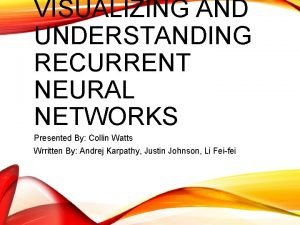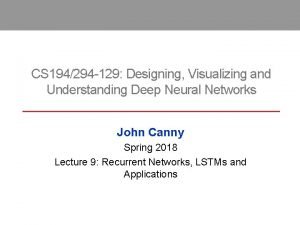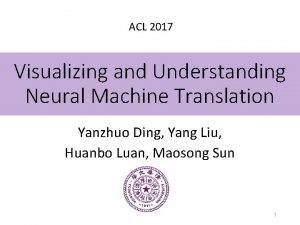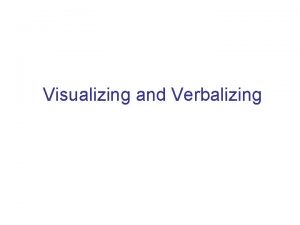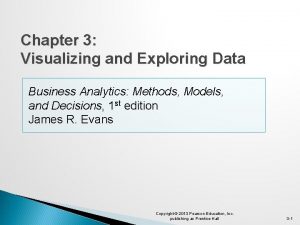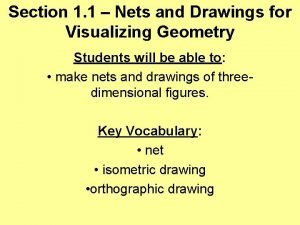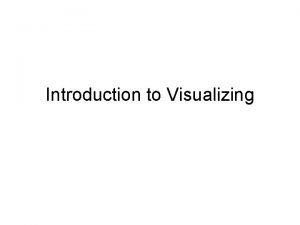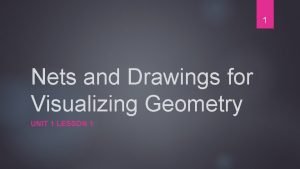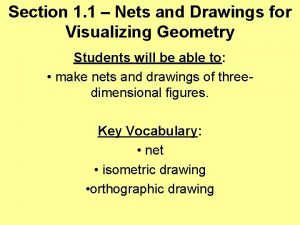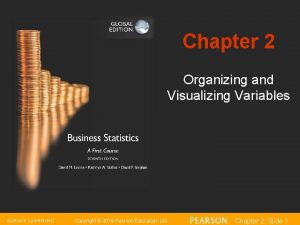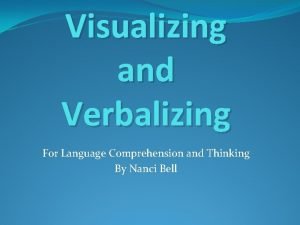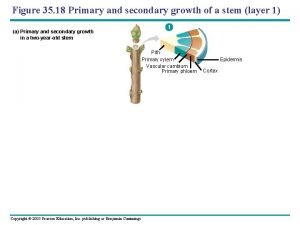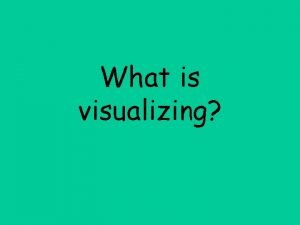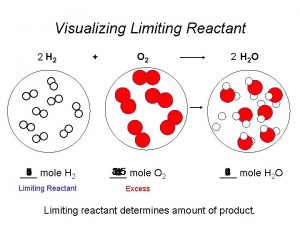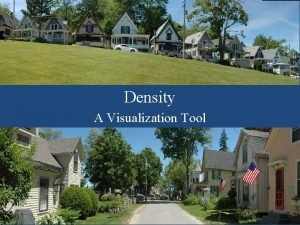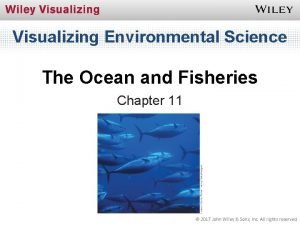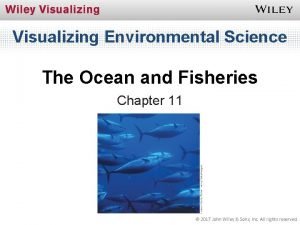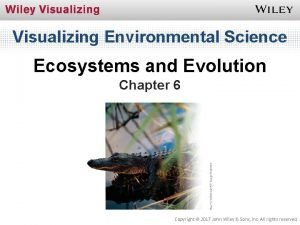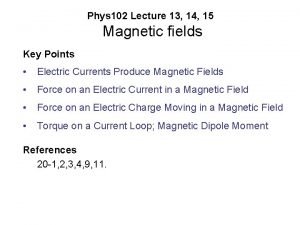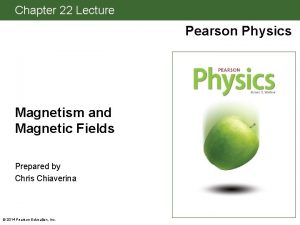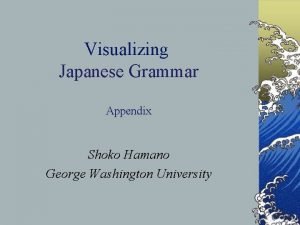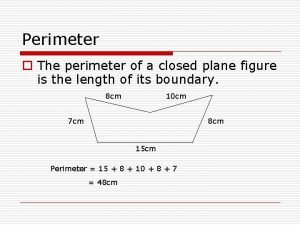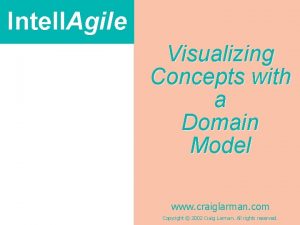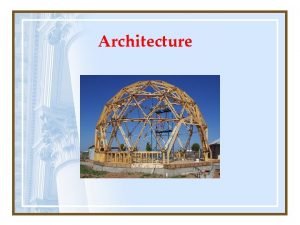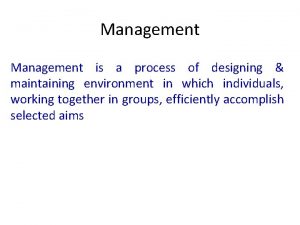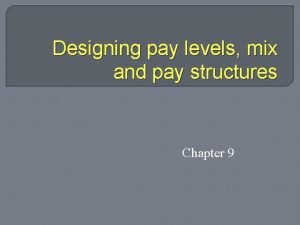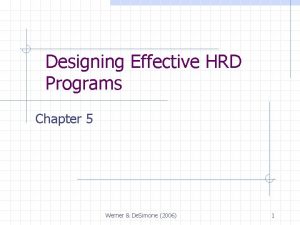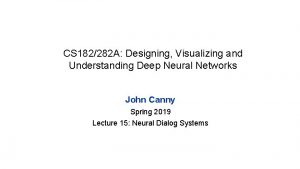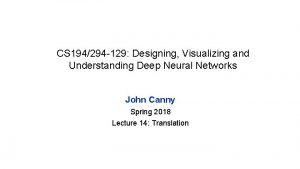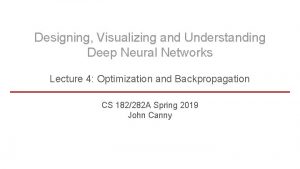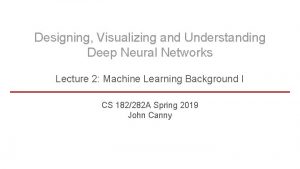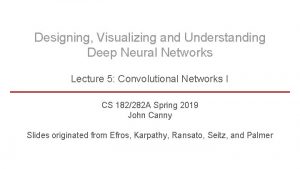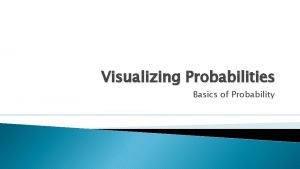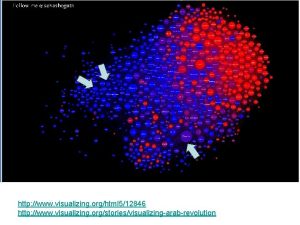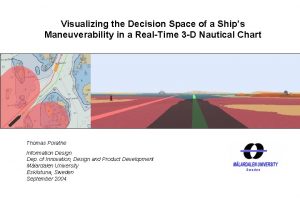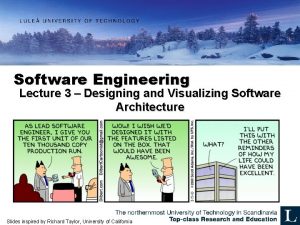CS 182282 A Designing Visualizing and Understanding Deep

































![Sample tasks for DSTC [13: 11] <user_1> anyone here know memcached? [13: 12] <user_1> Sample tasks for DSTC [13: 11] <user_1> anyone here know memcached? [13: 12] <user_1>](https://slidetodoc.com/presentation_image_h2/dc09d44988eb6392210a032793f6a06a/image-34.jpg)




- Slides: 38

CS 182/282 A: Designing, Visualizing and Understanding Deep Neural Networks John Canny Spring 2019 Lecture 15: Neural Dialog Systems

Last Time: Q&A Memory Network Single-layer Three-layer

Last Time: Multi-Hop Inference Note: Answers are single-word, predicted by the output softmax

Last Time: QANet – Convolution + Transformer

This Time: Dialog

Goal-Directed Dialog Systems, in contrast to chatbots, aim to not only engage the user, but help the user with goal-directed tasks. Traditional dialog systems use slot-filling: “We’d like a table for two at 8 pm, outside if possible” Fills slots for • Number of people • Time • Location preference The interaction may need several turns to: • Clarify users intention (slot doesn’t match) • Ask for a different option (request can’t be met) • Fill in missing slots

Machine Learning Goal-Directed Dialog The idea is to learn from sample dialog how to respond to user queries.

Task Summary Task 1: Issuing API calls. A user query contains from 0 to 4 of the required fields. Agent must ask questions for filling the missing. Task 2: Updating API calls. After an API call from. Task 1, user asks to update their requests. The agent ask user if they are done and issue the updated API call. Task 3: Displaying options. Given a user request, we query the KB to get possible responses. Task 4: Providing extra information. Users then ask for the phone number of the restaurant, its address or both. Task 5: Conducting full dialogs We combine Tasks 1 -4 to generate full dialogs just as in Figure 1. Bordes et al “LEARNING END-TO-END GOAL-ORIENTED DIALOG” ICML 2017

Datasets Restaurant Reservations: Contains two KBs of 4, 200 facts and 600 restaurants each (5 types of cuisine 5 locations 3 price ranges 8 ratings). Use one of the KBs to generate the standard training, validation and test dialogs, and use the other KB only to generate test dialogs, termed Out-Of-Vocabulary (OOV) test sets. Dialog State Tracking Challenge: Another restaurant booking dataset, but using data from real users. We use data from DSTC 2 (Henderson et al. , 2014 a), which was designed for dialog state tracking hence every dialog turn is labeled with a state (a user intent + slots) to be predicted. Online Concierge Service: Data extracted from a real online concierge service: users make requests through a text-based chat interface that are handled by human operators who can make API calls. Bordes et al “LEARNING END-TO-END GOAL-ORIENTED DIALOG” ICML 2017

Q&A Memory Network Single-layer Three-layer

Experiments Match type = extend entity descriptions with their type (cuisine type, location, price range, party size, rating, phone number and address) to help match OOV items. Supervised embedding = task-specific word embedding, using a margin loss on a prediction task. Bordes et al “LEARNING END-TO-END GOAL-ORIENTED DIALOG” ICML 2017

Experiments Ground Truth = held out transcripts. Note “display options” task includes user feedback:

BERT and Dialog Woman Man Queen King RNN ELMo Transformer Embeddings from Language Models GPT BERT Bidirectional Encoder Representations from Transformers

BERT is a language model (next word predictor) trained on a large dataset of natural language that is fine-tuned for particular tasks. But note that only GPT is a generative model.

GPT Generative Pre-Training (Open. AI) is a transformer-based generator using only a simplified transformer decoder stage: V K Q GPT Full transformer

GPT Generative Pre-Training (Open. AI) is a transformer-based generator using only a simplified transformer decoder stage: V K Q GPT Full transformer

GPT is trained initially on a large text corpus to minimize a language modeling loss Then for each task, a custom linear layer is added and the entire network retrained (with slower adjustment of the transformer weights). The language model loss is retained during task-specific retraining of the model.

GPT Generative Pre-Training can be applied to a variety of (non-generative) tasks:

GPT Task performance Entailment tasks (predict entailment, contradiction, or neutral): “Anne drove to work” “Anne has a job” if a person would say B is probably true given A.

GPT Task performance Question answering and commonsense reasoning: RACE contains questions from high-school and middle-school exams. Story Cloze is story completion

GPT 2 A depth-48 version of GPT trained on a massive dataset (Web. Text): A train carriage containing controlled nuclear materials was stolen in Cincinnati today. Its whereabouts are unknown. In an email to Ohio news outlets, the U. S. Department of Energy said it is working with the Federal Railroad Administration to find the thief. “The theft of this nuclear material will have significant negative consequences on public and environmental health, our workforce and the economy of our nation, ” said Tom Hicks, the U. S. Energy Secretary, in a statement. “Our top priority is to secure theft and ensure it doesn’t happen again. ” The stolen material was taken from the University of Cincinnati’s Research Triangle Park nuclear research site, according to a news release from Department officials. The Nuclear Regulatory Commission did not immediately release any information. According to the release, the U. S. Department of Energy’s Office of Nuclear Material Safety and Security is leading that team’s investigation. “The safety of people, the environment and the nation’s nuclear stockpile is our highest priority, ” Hicks said. “We will get to the bottom of this and make no excuses. ” 48 x

BERT is a bidirectional (Transformer encoder) model. K V Q

BERT is a bidirectional (Transformer encoder) model. K V Q

BERT is trained with two types of loss: • Word prediction: 15% of input words are removed and then re-predicted

BERT is trained with two types of loss: • Next sentence prediction: from an actual corpus of consecutive sentence pairs, create a dataset with 50% real pairs, and 50% “fake” pairs (where the second sentence is a random one).

BERT is trained with two types of loss: • Next sentence prediction: from an actual corpus of consecutive sentence pairs, create a dataset with 50% real pairs, and 50% “fake” pairs (where the second sentence is a random one). • This is an example of a very general loss for unsupervised learning called “contrastive loss”. The loss contrasts true positives with “near miss” negatives.

BERT Task specialization

BERT Task specialization

BERT Task specialization

BERT Performance BERT Base: L=12, H=768, A=12, total param =110 M BERT Large: L=24, H=1024, A=16, total param=340 M L=number of layers, H=model dimension, A=number of multi-attention heads Glue tasks

BERT Performance SQu. AD

Dialog DSTC = Dialog System Technology Challenge: • Sentence selection • Sentence generation • Audio-visual scene-aware dialog

Sample tasks for DSTC ADVISOR | Hi! What can I help you with? STUDENT | Hello! I'm trying to schedule classes for next semester. Can you help me? STUDENT | Hardware has been an interest of mine. STUDENT | But I don't want too hard of classes ADVISOR | So are you interested in pursuing Electrical or Computer Engineering? STUDENT | I'm undecided STUDENT | I enjoy programming but enjoy hardware a little more. ADVISOR | Computer Engineering consists of both programming and hardware. ADVISOR | I think it will be a great fit for you. STUDENT | Awesome, I think that's some good advice. STUDENT | What classes should I take to become a Computer Engineer? ADVISOR | You haven't taken EECS 203, 280, and 270, so it may be in your best interest to take one or two of those classes next semester STUDENT | Ok. Which of those is in the morning. I like morning classes
![Sample tasks for DSTC 13 11 user1 anyone here know memcached 13 12 user1 Sample tasks for DSTC [13: 11] <user_1> anyone here know memcached? [13: 12] <user_1>](https://slidetodoc.com/presentation_image_h2/dc09d44988eb6392210a032793f6a06a/image-34.jpg)
Sample tasks for DSTC [13: 11] <user_1> anyone here know memcached? [13: 12] <user_1> trying to change the port it runs on [13: 12] <user_2> user_1: and ? [13: 13] <user_1> user_2: I'm not sure where to look [13: 13] <user_1> ! [13: 13] <user_2> user_1: /etc/memcached. conf ? [13: 13] <user_1> haha [13: 13] <user_1> user_2: oh yes, it's much simpler than I thought [13: 13] <user_1> not sure why, I was trying to work through the init. d stuff Should also use external reference information from unix man pages.

DSTC 7 results

Co. QA https: //stanfordnlp. github. io/coqa/ Co. QA contains 127, 000+ questions with answers collected from 8000+ conversations. Each conversation is collected by pairing two crowdworkers to chat about a passage in the form of questions and answers.

Co. QA Leaderboard 3/20/19

Takeaways • Pre-training language models on very large corpora improves the state-of-the-art for multiple NLP tasks (ELMo, GPT, BERT). • Transformer designs (GPT and BERT) have superseded RNN designs (ELMo). • Single-task execution involves input encoding, a small amount of output hardware, and fine-tuning. • Bi. Directional encoder models (BERT) do better than generative models (GPT) at non-generation tasks, for comparable training data/model complexity. • Generative models have training efficiency and scalability advantages that may make them ultimately more accurate. They can also solve entirely new kinds of task that involve text generation.
 Visualizing and understanding recurrent networks
Visualizing and understanding recurrent networks Visualizing and understanding convolutional networks
Visualizing and understanding convolutional networks Visualizing and understanding recurrent networks
Visualizing and understanding recurrent networks Visualizing and understanding neural machine translation
Visualizing and understanding neural machine translation Deep asleep deep asleep it lies
Deep asleep deep asleep it lies Deep forest: towards an alternative to deep neural networks
Deep forest: towards an alternative to deep neural networks O the deep deep love of jesus
O the deep deep love of jesus What is visualizing
What is visualizing Visualizing and exploring data in business analytics
Visualizing and exploring data in business analytics 1-1 practice nets and drawings for visualizing geometry
1-1 practice nets and drawings for visualizing geometry Visualizing and verbalizing activities
Visualizing and verbalizing activities Analyzing and visualizing data with microsoft power bi
Analyzing and visualizing data with microsoft power bi 1-1 practice nets and drawings for visualizing geometry
1-1 practice nets and drawings for visualizing geometry Nets and drawings for visualizing geometry
Nets and drawings for visualizing geometry Net of a cube
Net of a cube Organizing and visualizing variables
Organizing and visualizing variables Organizing and visualizing variables
Organizing and visualizing variables Visualizing and verbalizing
Visualizing and verbalizing Visualizing primary and secondary growth
Visualizing primary and secondary growth What is visualizing?
What is visualizing? What is the limiting reactant
What is the limiting reactant Shoko hamano
Shoko hamano 200 feet visualized
200 feet visualized Visualizing environmental science solution manual
Visualizing environmental science solution manual Visualizing environmental science solution manual
Visualizing environmental science solution manual Visualizing environmental science (doc or html) file
Visualizing environmental science (doc or html) file Visualizing magnetic field
Visualizing magnetic field Electric currents and magnetic fields
Electric currents and magnetic fields Visualizing magnetic field
Visualizing magnetic field Visualizing physical geography
Visualizing physical geography Shoko hamano
Shoko hamano Complete the following table for each circle
Complete the following table for each circle Visualizing concepts
Visualizing concepts -is not one of the purposes for giving oral presentations.
-is not one of the purposes for giving oral presentations. Architecture is art and science
Architecture is art and science The process of designing and maintaining an environment
The process of designing and maintaining an environment Computer aided embroidery
Computer aided embroidery Designing pay structure
Designing pay structure Designing effective hrd programs
Designing effective hrd programs
